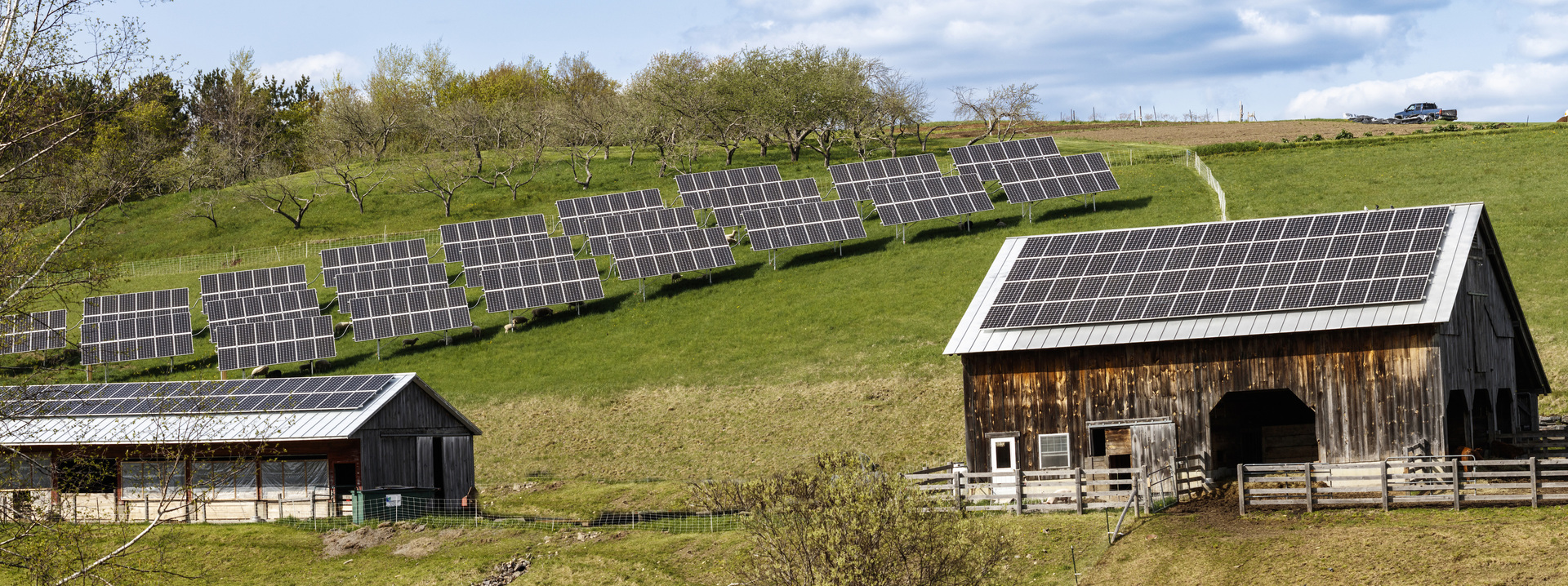A few weeks ago, Sol Systems hosted a screening of Sierra Club’s new film, Reinventing Power, at our Washington, D.C. headquarters. The documentary included vignettes of everyday citizens in communities across the United States who had been positively impacted by clean energy deployment, including Steve Harris, a North Carolina farmer who erected wind turbines on his family’s farm to help to provide financial security after some tough years.
[caption id="attachment_7005" align="alignright" width="300"] Vermont solar array on a sheep, pig, and cattle farm, powering 80 percent of its electricity needs. Photo by Emily Boren, Department of Energy (DOE)[/caption]
Vermont solar array on a sheep, pig, and cattle farm, powering 80 percent of its electricity needs. Photo by Emily Boren, Department of Energy (DOE)[/caption]
This story is a common one that our team encounters throughout our work, and it doesn’t just apply to wind farms. Solar provides predictable financial returns for landowners who lease their property for solar projects. Last week, a Sol team member spoke with a North Carolina landowner who told her, “Solar helped keep the family farm.” Analysis of North Carolina, the #2 solar market in the country, showed that solar leases typically have 15- to 30-year terms and rates range between $500 and $1,000 per acre per year. And farmers need only set aside a portion of their land for a solar project. As Illinois farmer Cathleen Lindauer told the Belleville News-Democrat, “It’s nice to diversify to help boost the farm’s bottom line.”
Solar farms also contribute significant tax revenue to state and local governments. On a dollar-per-acre basis, utility-scale solar generates more tax revenue than if that land were used for agriculture alone. Under new legislation passed in Illinois this year, each megawatt of ground-mounted solar will pay an average of $7,000 per year in property taxes, for a projected total of $250M to $350M in property tax revenue over 25 years. Sol advises solar developers to ensure their projects will contribute local tax revenue to the community.
[caption id="attachment_7003" align="alignright" width="300"] Sheep that live on solar farms keep the weeds and grass trimmed, especially in hard to reach places between and under panels. Photo by Merrill Smith, DOE[/caption]
Sheep that live on solar farms keep the weeds and grass trimmed, especially in hard to reach places between and under panels. Photo by Merrill Smith, DOE[/caption]
Ground-mounted solar may also be co-located with native plants that create pollinator-friendly habitats, or other agricultural activities like sheep raising. Honey producer Travis Bolton, who owns several bee hives co-located with solar projects, told Scientific American, “The advantage to these sites is that they are intentionally planted for pollinators. At these sites, they’re really trying to get them back to a native prairie, and that’s a benefit to us.”
The interests of solar energy development and agriculture need not be at odds. Developers should listen to the concerns and priorities of rural community members to ensure solar projects are well-sited, environmentally friendly, and provide a positive net value to the community. Successful engagement with farmers and other stakeholders is the first step in ensuring that solar leases provide predictable financial returns for landowners, while working hand-in-hand with agriculture to support the natural environment in rural communities across the country. And that’s a beautiful thing.
This is an excerpt from the December 2018 edition of The SOL SOURCE, a monthly electronic newsletter analyzing the latest trends in renewable energy based on our unique position in the solar industry. To receive future editions of the journal, please subscribe.
ABOUT SOL SYSTEMS
Sol Systems, a national solar finance and development firm, delivers sophisticated, customized services for institutional, corporate, and municipal customers. Sol is employee-owned, and has been profitable since inception in 2008. Sol is backed by Sempra Energy, a $25+ billion energy company.
Over the last ten years, Sol Systems has delivered 800 MW of solar projects for Fortune 100 companies, municipalities, universities, churches, and small businesses. Sol now manages over $650 million in solar energy assets for utilities, banks, and Fortune 500 companies.
Inc. 5000 recognized Sol Systems in its annual list of the nation’s fastest-growing private companies for four consecutive years. For more information, please visit www.solsystems.com



